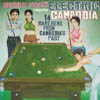Dengue Fever Presents: Electric Cambodia
 This compiles 14 rare tracks from innocent, energetic and progressive 1960s and early 1970s Cambodia; a time which Pol Pot and the Khmer Rouge (with plenty of help from Western friends) would attempt to obliterate.
This compiles 14 rare tracks from innocent, energetic and progressive 1960s and early 1970s Cambodia; a time which Pol Pot and the Khmer Rouge (with plenty of help from Western friends) would attempt to obliterate.
Dengue Fever Presents: Electric Cambodia blends Western guitar pop and Eastern traditional folk music. The whole album swells with joyous lively life-affirming twanging and spirited wailing in vivid contrast to the somber fact that several of the artists, such as Pan Ron, Sinn Sisamouth and Ros Sereysothea, were victims of the Year Zero genocide in Cambodia.
The singing on some of these pieces is extraordinary. I particularly like Ros Sereysothea on “Cold Sky,” “I Will Starve Myself To Death,” and “Flowers In The Pond.” Her voice is simultaneously cool and yet slightly raunchy, albeit suggestive of a raunchiness which perspires rather than sweats. Pan Ron is devastating on “I Want To Be Your Lover.” There is also “Snaeha,” a Khmer version of Sonny and Cher’s “Bang Bang,” which is hard to hear without either detecting (or projecting) traces of Morricone. Similarly, “I Want To Shout” is inspired by the Isley Brothers’ early hit “Shout” most famously covered elsewhere by miniature sex-bomb, Lulu.
Western influence is easily spotted; indeed an alarming hint of Santana rears its head once or twice along with surf and garage sounds. Other passages are gloriously otherworldly, though, and tracks which may at first sound like a band fronted by a duck with an effects pedal and a gargling hyena quickly become familiar and affecting. Most of the accompaniment is pleasantly sparse allowing both instrument and voice to enjoy plenty of space. “Hope To See You” has an early psychedelic feel with shuffling drum, wobbling guitar to the fore and minimal organ adding depth. The title of that piece is poignant as is the credit to Unknown Artist. The album also has one Pan Ron track missing its title but otherwise all has been identified by the elder sister of Dengue Fever’s Chlom Nimol.
Electric Cambodia demonstrates that the will and innocence of people cannot be destroyed. Totalitarian regimes may grind bones, burn flesh and hair, drain blood, and demand silence, yet something will always remain. And, of course, the story of what happened to some of these artists and millions of other people isn’t as simple as Henry “Why should we flagellate ourselves for what the Cambodians did to each other?” Kissinger would have us believe.
Pol Pot was a murderous individual and his Khmer Rouge regime did many evil things, but as John Pilger has written “Pol Pot and the Khmer Rouge would be historical nonentities—and a great many people would be alive today—had Washington not helped bring them to power and the governments of the United States, Britain, China and Thailand not supported them, armed them, sustained them and restored them.” Cambodia suffered a US land invasion in 1970 and from 1969-1973 was secretly bombed at the behest of Nixon and Kissinger killing approximately three quarters of a million people. “Phosphorous and cluster bombs, napalm and dump bombs that left vast craters were dropped on a neutral country of peasant people and straw huts.” According to declassified documents, these acts gave the Khmer Rouge it’s best recruiting tool and platform for the revolution which began on April 17, 1975. Just after sunrise on that day, Pol Pot’s notorious Year Zero began a repugnant and still scarcely believable era of “purification,” slavery, and extermination that claimed at the very least another two million lives.
Unfortunately, the Cambodian Holocaust has a third stage. In January 1979, tired of attacks across their border, the Vietnamese liberated Cambodia and the bloodshed and suffering should have ended there. But “Commie” liberators were too much for the US and its allies to bear. Vietnam had already ousted the US from their country and this was a time when the domino theory of countries falling under Communist influence was prevalent. As Pilger reports “The Khmer Rouge were restored in Thailand by the Reagan administration, assisted by the Thatcher government, who invented a "coalition" to provide the cover for America's continuing war against Vietnam.” Reagan’s administration swiftly began backing Pol Pot in exile. The US and the UK used the United Nations to construct a blockade making Cambodia the only Third World country so isolated. The special relationship between Reagan and Thatcher also extended to having the CIA and the SAS train the Khmer Rouge in Thailand and Malaysia.
John Pilger’s writing for the Daily Mirror and an ATV documentary he made with David Munro brought forth an unsolicited response from ordinary people in Britain. Single mothers gave their meager savings, workers sent their weekly wages and £20M was raised for aid. Reports suggests that those actions defied the blockade, supporting orphanages, restocking hospitals and schools, restoring clean water and clothing.
Proceeds from Dengue Fever Presents: Electric Cambodia will benefit Cambodian Living Arts which is devoted to traditional and forward looking performing arts and creative expression. The album was compiled by Dengue Fever from cassette mix-tapes circulated from friend to friend. As someone who used to make and send compilation tapes it is impossible to imagine the widespread murder of those friends and of the artists whose music we shared. Also of note is S21: The Khmer Rouge Killing Machine, a documentary by the Paris-based Khmer director Rithy Panh, whose parents died in the terror. The film brings together victims and “the ordinary and obscure journeymen of the genocide" (as Panh calls them) the torturers and murderers.
samples:



